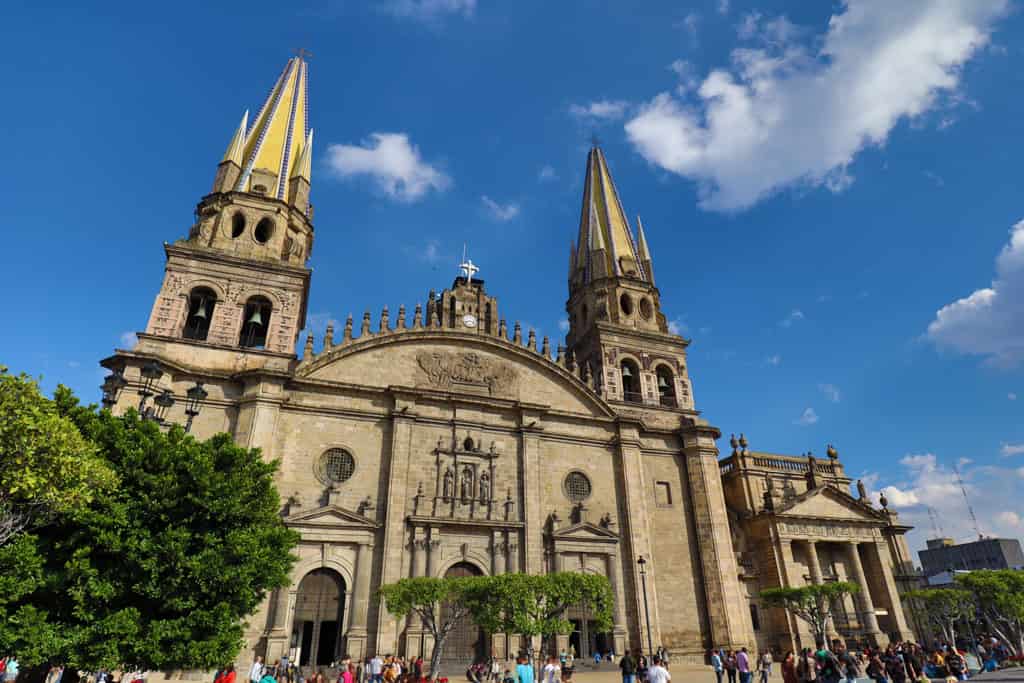15 Best Cathedrals In Mexico: Epic Religious Architecture
Mexico has a rich architectural and historic legacy that can be seen in its cathedrals. During the Spanish colonial period, great wealth was allocated to the construction of Cathedrals in Mexico. The minerals extracted from Mexico would not only establish Spain as a global superpower but also sponsor a wave of missionaries to evangelize the Native people.
Spanish conquistadors introduced the Catholic religion to the new world and the Spanish Inquisition maintained a strict monopoly for centuries. To this day, Mexico is a predominantly Catholic country with more Catholic churches than that of all other denominations combined.
Today, The UNESCO World Heritage Site Program has recognized the historic city centers of Mexico City, Oaxaca, Puebla, Morelia, Zacatecas, and Queretaro for their historic and cultural value. Each of those city centers was built around a magnificent Cathedral.
Visiting the Cathedral is a great way to begin exploring a new city. The history of the city can often be heard through stories of adversity and triumph. For somebody living in the 21st century, it is often hard to imagine how the grand Cathedrals of Mexico were built using technology from the 16th century.
An Overview Of The Cathedrals In Mexico
Mexico is home to a large number of awe-inspiring Cathedrals, basilicas, and temples. The word Cathedral comes from the Latin word for seat in reference to a bishop. Bishops provide governance for a diocese, a group of churches in a geographic region.
Many of Mexico’s oldest cities were built around a main square and a church. In some cases, the Spanish built their churches on top of the Native temples merely recycling the stone blocks from the earlier ceremonial centers such as the Aztec Templo Mayor.
The oldest churches in New Spain were simple religious buildings but as Spanish immigration increased more talented architects arrived in search of opportunity. Many Spanish tradesmen, lured by tales of unimaginable riches, immigrated to Latin America in the 16th century to help build the new cities.
Hernán Cortés, appointed a governor by King Charles, acquired silver mines and initiated the development of Mexico City. To this day, the Mexico City Metropolitan Cathedral is the finest Cathedral in Mexico with the most thrilling history and spectacular design.
1. Mexico City Metropolitan Cathedral

Catedral Metropolitana de la Asunción de la Santísima Virgen María a los Cielos de la Ciudad de México
Submitted by Soumya of Stories by Soumya
The Metropolitan Cathedral of Mexico City is the largest cathedral in Mexico and one of the most impressive cathedrals in Latin America. Located next to the National Palace in the Plaza de la Constitución, the Zócalo is a place of important historical significance dating back to the 14th century.
Designed by Spanish architect Claudio de Arciniega in the 16th century, the Cathedral was built in sections over the course of 250 years. Architect and sculptor Manuel Tolsá was in charge of completing the project from 1793-1813. He would go on to Guadalajara and build the Hospico Cabañas.
After the conquest of the Aztec Empire, the Cathedral was built over the ruins of an ancient Aztec temple called the Templo Mayor with the same stone. It displays a unique mix of architectural styles including Baroque, Gothic, and Churrigueresque.

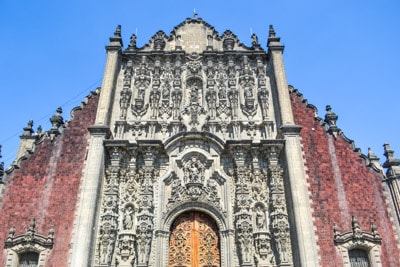
With a towering Gothic façade and ornately decorated interiors, the Metropolitan Cathedral is a UNESCO World Heritage Site and one of the most imposing monuments in downtown Mexico City.
Check out the cathedral’s Altar of the Kings, a magnificent example of Churrigueresque architecture. The Cathedral is also home to an image of Christo Negro or Black Christ, a highly venerated figure in Central America.
Mexico City’s Metropolitan Cathedral is open from 9:00 a.m. to 5:30 p.m. every day of the year and is free to enter. A small fee is required for the sacristy and the choir.
The best way to visit the Metropolitan Cathedral is on a guided tour of the historic center where you’ll learn all the history of the church as well as interesting legends and myths associated with it.
2. Guadalajara Metropolitan Cathedral
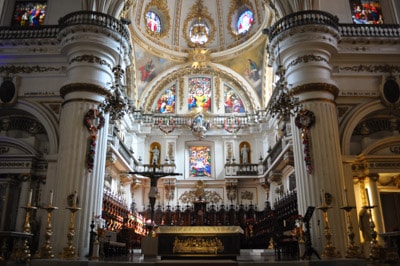


Catedral Basílica de la Asunción de María Santísima
The Guadalajara Metropolitan Cathedral is one of the most identifiable churches in the country because of its distinctive yellow gothic bell towers. When the capital of Nueva Galicia was moved to Guadalajara in the 16th century both the bishopric and King Felipe II decided they needed a Cathedral worthy of a provincial capital city. The first Cathedral in Guadalajara was a humble adobe building that burnt down in a fire.
While the first stone was placed in 1561, construction didn’t really get going until 1571. The Spanish architect Martín Casillas is credited with designing the Cathedral even though he did not arrive in the world until 1573.
Construction of the Cathedral was completed in 1618 but would not be consecrated until 1716. In 1818 and later again in 1849, strong earthquakes would damage the church and bring down the bell towers.
In 1854, architect Manuel Gómez Ibarra completed new bell towers in a completely different neo-gothic architectural style and covered with yellow tile. To this day the bell towers of the Guadalajara Cathedral are in danger of collapse and have been reinforced with steel cages.
The facade of the Cathedral is considered to be a mixture of different styles including neo-classical and Renaissance. The doorways are surrounded by columns and have a triangle shape at the top. All of the stone was locally sourced from the Barranca de Huentitan.
There are four plazas on either side of the Cathedral forming the shape of the cross when viewed from above. The historic center of the city is full of museums and plazas that are connected by pedestrian streets. Visiting the Cathedral is one of the most interesting things to do in Guadalajara and needs to be on your list.
3. Puebla Metropolitan Cathedral

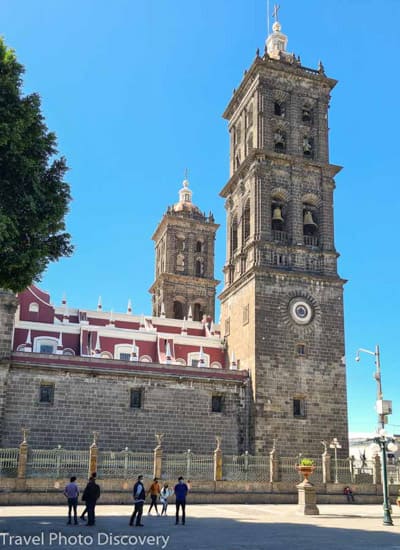

Catedral Basílica de Nuestra Señora de la Inmaculada Concepción de Puebla
Submitted by Noel Morata of Travel Photo Discovery
One of the oldest cities in Mexico, a visit to Puebla is a must and the grand cathedral of Puebla is one of the most magnificent structures and churches built in Mexico. The cathedral of Puebla is called the Cathedral of Our Lady of Immaculate Conception and was dedicated in 1653 and founded by Phillip ll of Spain. The cathedral and historic center of Puebla are part of the Unesco World Heritage Site with the church as the main centerpiece overlooking the main square and other significant buildings in the downtown area.
The church grounds are massive and take an entire side of the main plaza in Puebla and the interiors are elaborate and striking. Created in the Herrerian style at the height of the Spanish Renaissance period. Inside you’ll find many treasures to include: Impressive carpentry work and details, gorgeous decorations, sculpture, beautiful paintings, goldsmithing, and the treasures of the sacristy that include sacred vessels, chalices, reliquaries, and elaborate crosses made with gold, diamonds, and precious stones. There is a historical archive that dates back to the founding of the city with many important documents and works.
You’ll be impressed with the grand scale and intricate details of both the interior and exteriors of the cathedral of Puebla and can spend a lot of time admiring all the beautiful craftsmanship. Once you’re done head out the to main plaza or zocalo and enjoy the gardens, water fountains, and even the colorful Visit Puebla sign to take some fun selfies of the sign and plaza area.
4. Morelia Metropolitan Cathedral

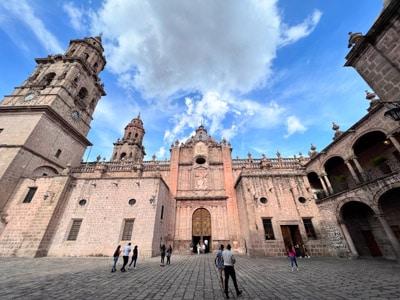

Catedral de la Transfiguración del Señor de Morelia
With pink quarry stone, baroque style, and towers standing over 66 meters tall, the Morelia Metropolitan Cathedral has to be one of the greatest works of colonial architecture. Bishop Fray Marcos Ramírez Del Prado laid the first stone of the temple on May 6, 1660. It was not finished until 1744, 84 years later. This is much later than the Cathedrals in the other large provincial capitals of New Spain.
The design of the Cathedral is attributed to the Italian architect, Vicenzo Barroccio. There is a great deal of resemblance between the Cathedrals in Morelia, La Ciudad de México, Puebla, and even the interior of the Guadalajara Cathedral.
This is the only Cathedral in Mexico that is facing north and not to the south.
In February 2016, the Morelia Cathedral was visited by Pope Francisco making it one of the few churches in Mexico to be visited by a Pope.
Morelia is one of the most beautiful cities in Mexico and needs to be on your list of places to visit.
5. Oaxaca Metropolitan Cathedral

Catedral de Nuestra Señora de la Asunción de Oaxaca
Submitted by Julien Casanova of Oaxaca Travel Tips
Nestled in the heart of Oaxaca City, the impressive Metropolitan Cathedral of Our Lady of the Assumption is an architectural gem. Visiting the cathedral and adjacent Zocalo is included in the best things to do in Oaxaca City.
Construction of the Oaxaca Cathedral was completed in several stages over a period of 200 years, beginning in 1535. As a result of the long construction time and damage from earthquakes, the cathedral is a combination of architectural styles.
Most notable is the Baroque facade, whose intricately carved statues decorate the green quarry stone building. Inside the Cathedral of Oaxaca, you’ll notice the cathedral’s thick stone walls and columns, impressive series of archways, and large domes.
The chapel located in the back left of the cathedral holds a statue of Christ that was brought from Spain in the 16th century. As the legend goes, the chapel where this statue was initially placed was struck by lightning which caused a devastating fire. Nearly everything was destroyed, except the crucifix which has since been referred to as the Lord of Lightning.
The Cathedral of Oaxaca is located on Av. de la Independencia, just north of the Zocalo. The area surrounding the church is particularly lively when families gather in the evenings. On Wednesdays, the Zocalo hosts an evening of Cuban dance which you can watch or participate in free of charge.
6. San Luis Potosí Metropolitan Cathedral

Catedral de Nuestra Señora de la Expectación
Submitted by Julie of Julie Around the Globe
San Luis Potosí Cathedral, known as Catedral de Nuestra Señora de la Expectación in Spanish, was built at the beginning of the 18th century on the site of a smaller church which was destroyed to make space for the cathedral.
But it wasn’t until 1854 that it officially became a cathedral and was remodeled into what we can mostly see today.
It has a Baroque façade made of pink stone, typical of the area. Notice the 2 towers, one is from 1730 and made of limestone and boulders while the other is from 1910 and is made of gray stones.
In the North Tower, you’ll find the only organ in Mexico that can be both controlled remotely and played directly. It was added in 2010 to celebrate the Bicentennial of the Independence of Mexico.
The inside of the cathedral is decorated in the Neoclassical style, with 3 naves. The main altar is typical of Mexican religious architecture, with a large “Ciprés“, a type of platform, here with a statue of King Louis the 9th and one of Our Lady of the O.
The cathedral is located in the city’s historic district (address: José María Morelos y Pavón 620.) You can attend mass (in Spanish) and visit it freely outside of the mass schedule.
San Luis Potosí’s historic district, a UNESCO World Heritage Site as part of the Camino Real de Tierra Adentro, is also worth visiting with plenty of museums, squares, and beautiful buildings to see. There are guided walking tours available as well as open-top buses.
The state of San Luis Potosí is home to the Huasteca Potosina known for its beautiful waterfalls, charming Pueblos Magicos, and thrilling outdoor activities.
7. Cuernavaca Metropolitan Cathedral

Catedral de Nuestra Señora de la Asunción de Cuernavaca
Submitted by Soumya of Stories by Soumya
One of the best things to do in Cuernavaca is to visit the Cathedral of the Assumption of Mary, a 16th-century Roman Catholic Church that is also an important pilgrimage site in Mexico.
The Cuernavaca Cathedral is an impressive example of the early, fortress-like architectural style adopted by the first missionaries in Latin America. Because of its extensive use of wide-open spaces and local imagery alongside Renaissance and Mudejar architecture, the Cuernavaca Cathedral is listed by UNESCO as one of the Earliest Christian Monasteries on the Slopes of Popocatepetl.
Inside the cathedral, you’ll see numerous murals adorning the walls of the church. A massive painting depicting the life and martyrdom of St. Philip of Jesus and other missionaries who were persecuted in Japan covers the right wall.
The Cathedral has several smaller chapels including an open chapel or Capella Abierta. Open chapels were characteristic of early cathedrals in Mexico and were used for large-scale evangelization.
The Cathedral is also home to a Museum of Religious Art that displays a small but remarkable collection of religious paintings and sculptures.
8. Cathedral of Mérida, Yucatán

Catedral de San Ildefonso de Yucatán
Submitted by Eleanor of Elevate Your Escapes
The Catedral de Mérida – San Ildefonso is located right in the heart of Mérida. It is a showcase of the city’s rich history and architectural heritage. Construction of the cathedral began in 1561, making it the oldest Cathedral in Mexico and one of the oldest in the western hemisphere. Its architecture showcases a blend of different styles, including Renaissance, Gothic, and Baroque.
The cathedral’s facade features nicely carved reliefs depicting scenes from the Bible. The inside has stunning altars, frescoes, and chapels. When visiting, check the cathedral’s schedule for Mass and cultural events.
Nearby, visitors can explore Plaza Grande, where you can find Casa Montejo – a colonial mansion that’s now a cool museum. There is also a famous letters sign in the main square. Get your photo there!
The city of Merida is renowned for its food scene, with restaurants serving delicious Yucatecan cuisine, like cochinita pibil and papadzules. The local markets are the best places to get this authentic food.
- Cathedral Address: Plaza Mayor, Centro, 97000 Mérida, Yucatán, Mexico.
9. Basilica Cathedral of Mazatlán



Catedral Basílica de la Inmaculada Concepción de Mazatlán
Submitted by Karen of Forever Karen
The Cathedral Basilica of the Immaculate Conception, or Mazatlán Cathedral, is a classic example of Gothic Revival architecture. Built between 1856 and 1899, you can find the cathedral near the Plaza Machado in Old Mazatlán.
If you’re visiting the city by cruise ship, it’s an 18-minute walk from the Mazatlán cruise port to the cathedral, located at 21 de Marzo. Its yellow façade dominates the skyline.
Interestingly, the cathedral has a Star of David in one of its stained-glass windows. The inclusion of the star is a mystery. Some theories suggest it’s a tribute to a Jewish benefactor who helped fund the church’s construction.
While it’s free to visit, the cathedral gratefully accepts donations. Inside, you’ll find multiple altars, each adorned with intricate details and splashes of gold. The main altar is incredibly eye-catching, featuring a mix of Gothic and Baroque styles.
The three naves have octagonal dome ceilings with beautiful chandeliers. Underfoot, black and white checkerboard tiles fill the place of worship.
One unique feature is its organ, built by Aristide Cavaille-Coll in Paris, France. The organ was imported in 1899, adding a European touch to this Mexican landmark. The blend of local and foreign elements makes the cathedral a significant cultural hub, loved by both residents and visitors.
While in the area, be sure to walk Calle Ángel Flores. This street features 19th-century homes in vibrant colors, often teeming with bougainvillea.
10. La Paz Cathedral

Catedral de Nuestra Señora de La Paz
Submitted by Lucy & Dan of Thoroughly Travel
Located on the Gulf of California, La Paz is the vibrant capital of Mexico’s Baja California Sur peninsula. At its center is the charming Nuestra Señora de La Paz Cathedral. A charming 19th-century neoclassical church, La Paz Cathedral is one of the Great Cathedrals of Mexico.
Featuring twin bell towers on the outside and Baroque altarpieces inside, La Paz Cathedral is located on the site where the mission was founded by the Jesuits a century before the current church was built. Overlooking the central plaza, Jardín Velasco, La Paz Cathedral is a stone’s throw from the Museum of Art, as well as the Museum of Anthropology, where you can learn more about the history of the peninsula. The malecón (a seaside promenade), is close by too. Decorated with marine-themed sculptures created by local artists, this is a great place for a walk or bike ride.
11. Campeche Cathedral

Catedral de la Purísima Concepción de Campeche
Submitted by Lori Blalock of Southerner Says
The Catholic Cathedral in Campeche was built over the course of 110 years from 1650 to 1760. The origins of the church on this site date back to the 16th century, King Carlos V, and Francisco Montejo. However, the church wasn’t elevated to Cathedral status until 1895 by Pope León XIII.
The architecture of the Cathedral in Campeche is rather simple. The exterior facade has neo-classic influences with an arched main door and Roman columns. Interestingly, the bell towers are named “La española” and “La campechana”. There is one large nave in the shape of a cross and a pyramid-shaped altar.
Located in the Plaza de la Independencia of the historic core of San Francisco Campeche, the Cathedral is situated inside the fortified section of the city.
12. Hermosillo Metropolitan Cathedral

Catedral de la Asunción de Hermosillo
The Hermosillo Metropolitan Cathedral happens to be one of the best examples of eclectic religious architecture in Mexico. This was very popular when it was built at the end of the 19th century and the beginning of the 20th century. An eclectic style means that there is an amalgamation of very different historic styles like neo-classical, neo-gothic, and baroque architecture.
Even though the Cathedral was consecrated in 1908, construction was not finished. In fact, one of the towers was missing and the dome was not finished until 1963.
Hermosillo is one of my favorite places to stop when driving from Nogales to Guadalajara. I highly recommend spending a little time eating carne asada and visiting the Cathedral.
13. Basilica Catedral of Culiacán

Catedral Basílica de Nuestra Señora del Rosario
The Catedral Basílica de Nuestra Señora del Rosario is one of the defining buildings of the Culiacán skyline. The famous church dates back to 1842 and was completed in 1885. The predominant architectural style is neo-classic and the pink stone is memorable, especially around sunset in Culiacán. There is a statue of Saint Michael, patron saint of the city, defeating a demon.
Culiacán is one of the most misunderstood cities in Mexico. Spending a little time eating seafood and visiting important historical sites will help you better appreciate the rich culture of Sinaloa.
14. Tepic Cathedral

Catedral de la Asunción de María de Tepic
Photo Submitted by Lori Blalock of Southerner Says
The Tepic Cathedral is a fine example of neo-gothic architecture that appears to be centuries old. It turns out that the original building that was built in 1750 had to be torn down.
The building that we know today was begun in the early 19th century and was concluded in 1885. The church was designated a Cathedral by Pope León XIII in 1891.
Visiting Downtown Tepic and the Cathedral is one of the most enjoyable things to do in Tepic.
15. Tijuana Cathedral



Santuario de la Virgen de Guadalupe
For the moment, the Santuario de la Virgen de Guadalupe is the main cathedral of Tijuana. There has been talk of building a new Cathedral since the 1970s but the effort didn’t pick up steam until 2017.
Currently, in 2023, the property has been acquired in the Zona Río neighborhood and construction is underway. The new Tijuana Metropolitan Cathedral has a lot more space than the downtown location does with plenty of parking. It is located in the Zona Rio Urbano neighborhood across the street from City Hall.
The Santuario de la Virgen de Guadalupe is located in Downtown Tijuana right on the border of the red light district. There is limited parking and it isn’t a place that wealthy families want to be walking back to their cars after a late Christmas service.
The church building is nice but simple compared to the rest of the Cathedrals on this list. There are two towers and a unique checkerboard pattern to the bricks oscillating between a peach and a cream color. The main door is framed by Roman columns and has an image of the Virgin of Guadalupe.
Until the late 1800s, the Tijuana parish churches fell under the Diocese of Sonora and missionaries from California celebrated mass. It wasn’t until the 1940s that Tijuana started to develop into a city of commerce. The Santuario de la Virgen de Guadalupe was finished in 1956. The Diocese of Tijuana was organized in 1964. It wasn’t until 2006 that Tijuana was elevated to an archdiocese and the temple elevated to a Cathedral.
Visiting the Santuario de la Virgen de Guadalupe is an important stop when exploring Tijuana.
List Of All The Cathedrals In Mexico
Something interesting that I learned while researching this article is that the Cathedrals in Mexico are not organized by states as I had originally thought to organize my article.
The Catholic Church organizes the dioceses according to ecclesiastical provinces. Many of the ecclesiastical provinces have existed much longer than the modern states have.
La Provincia eclesiástica de Acapulco
The Acapulco Ecclesiastical Province is made up of the state of Guerrero, two municipalities of the state of Michoacán, and the southwest portion of México State.
- Acapulco (Archdiocise)
- Chilpancingo-Chilapa
- Ciudad Altamirano
- Tlapa
Provincia eclesiástica de Antequera de Oaxaca
The Antequera de Oaxaca Ecclesiastical Province is comprised of most of the state of Oaxaca.
- Antequera Oaxaca (Archdiocise)
- Puerto Escondido
- Tehuantepec
- Tuxtepec
- Huautla
- Mixes
Provincia eclesiástica de Chihuahua
The Ecclesiastical Province of Chihuahua is comprised of the state of Chihuahua.
- Chihuahua
- Ciudad Juárez
- Cuauhtémoc-Madera
- Nuevo Casas Grandes
- Parral
- Tarahumara
Provincia eclesiástica de Durango
La Provincia eclesiástica de Durango comprende parte del estado de Durango, municipios del sur del estado de Coahuila y municipios del sur del estado de Sinaloa.
- Arquidiócesis de Durango
- Gómez Palacio
- Mazatlán
- Torreón
- El Salto
Provincia eclesiástica de Guadalajara
The Ecclesiastical Province of Guadalajara is comprised of the states of Jalisco, Aguascalientes, Colima, and Nayarit, and parts of the states of Durango and Zacatecas.
- Arquidiócesis de Guadalajara
- Aguascalientes
- Autlán
- Ciudad Guzmán
- Colima
- San Juan de los Lagos
- Tepic
Provincia eclesiástica de Hermosillo
The Ecclesiastical Province of Hermosillo is comprised of the state of Sonora and several municipalities in northern Sinaloa.
- Arquidiócesis de Hermosillo
- Nogales
- Ciudad Obregón
- Culiacán
Provincia eclesiástica de León
The Ecclesiastical Province of León is comprised of the state of Guanajuato and municipalities in Querétaro.
- Arquidiócesis de León
- Celaya
- Irapuato
- Querétaro
Provincia eclesiástica de la Ciudad de México
The Ecclesiastical Province of Mexico City is made up of the Mexico City Metropolitan Area.
- Arquidiócesis de México
- Iztapalapa
- Azcapotzalco
- Xochimilco
La Provincia Eclesiástica de Monterrey
The Ecclesiastical Province of Monterrey is comprised of the states Nuevo León, Coahuila and Tamaulipas.
- Monterrey (Archdiocise)
- Piedras Negras
- Saltillo
- Nuevo Laredo
- Linares
- Matamoros
- Ciudad Victoria
- Tampico
Provincia eclesiástica de Morelia
The Ecclesiastical Province of Morelia is comprised of the state of Michoacan and municipalities of the southwest part of Guerrero State.
- Arquidiócesis de Morelia
- Apatzingán
- Lázaro Cárdenas
- Tacámbaro
- Zamora
Provincia eclesiástica de Puebla
The Ecclesiastical Province of Puebla is comprised of the state of Puebla, Tlaxcala, and part of Oaxaca.
- Arquidiócesis de Puebla de los Ángeles
- Huajuapan de León
- Tehuacán
- Tlaxcala
Provincia eclesiástica de San Luis Potosí
The Ecclesiastical Province of San Luis Pososí is comprised of the state of San Luis Potosí and part of the state of Zacatecas.
- Arquidiócesis de San Luis Potosí
- Ciudad Valles.
- Matehuala
- Zacatecas
Provincia eclesiástica de Tijuana
The Ecclesiastical Province of Tijuana is comprised of the states of Baja California and Baja California Sur, and a little bit of the state of Sonora.
- Arquidiócesis de Tijuana
- Ensenada.
- La Paz
- Mexicali.
Provincia eclesiástica de Tlalnepantla
The Ecclesiastical Province of Tlalnepantla is comprised of the part of the state of México the lies next to Mexico City.
- Arquidiócesis de Tlalnepantla
- Cuautitlán
- Ecatepec
- Nezahualcóyotl
- Teotihuacán
- Texcoco
- Valle de Chalco
- Diócesis de Izcalli
Provincia eclesiástica de Toluca
The Ecclesiastical Province of Toluca is comprised of part the state of Mexico and all of the state of Morelos.
- Arquidiócesis de Toluca
- Atlacomulco
- Cuernavaca
- Tenancingo
Provincia eclesiástica de Tulancingo
The Ecclesiastical Province of Tulancingo is comprised of the state of Hidalgo, a couple municipalities of Mexico State, part of Puebla State, and part of Veracruz State.
- Arquidiócesis de Tulancingo
- Huejutla
- Tula
Provincia eclesiástica de Tuxtla Gutiérrez
The Ecclesiastical Province of Tuxtla Gutiérrez is comprised of the state of Chiapas.
- Arquidiócesis de Tuxtla Gutiérrez
- San Cristóbal de las Casas
- Tapachula
Provincia eclesiástica de Xalapa
The Ecclesiastical Province of Xalapa is comprised of most of the state of Veracruz
- Arquidiócesis de Xalapa
- Coatzacoalcos
- Córdoba
- Orizaba
- Papantla
- San Andrés Tuxtla
- Tuxpan
- Veracruz
Provincia eclesiástica de Yucatán
The Ecclesiastical Province of Yucatán is comprised of the states of Yucatán, Campeche, Tabasco and Quintana Roo.
- Arquidiócesis de Yucatán
- Campeche
- Tabasco
- Cancún-Chetumal
Cathedrals In Mexico FAQ
These are the questions that I had when I started researching this article.
What is the difference between a Cathedral and a parish church?
A church is any building that is used for religious worship, typically of the Christian faith. A Cathedral is a church that is organized by a bishop. The word Cathedral actually comes from the word for seat in reference to the seat of the bishop. Cathedrals are important churches that govern a province of the Catholic Church.
Final Thoughts On The Cathedrals In Mexico
I read a book by Ken Follet a number of years ago that got me interested in the building of historic churches. Pillars of the Earth is about the construction of the great temples of England in the 12th century. It is the story of a builder, his family, and some priests in an imaginary town in England, and later France and Spain. What I loved about the book was the way that Follet could humanize people who lived 900 years ago. The book is an epic because it took so long to build a Cathedral we get to hear the life story of the family and the town against the backdrop of historical events.
As I was reading the book, I started visiting the historic churches in Downtown Guadalajara, touching the columns and thinking about the people who built them. Many of the historical events in Mexico had an effect on the great Cathedrals. I love reading about the architects and priests who moved across the globe to make these Cathedrals possible. I still attribute Guadalajara’s affinity for art and architecture to the influx of tradesmen who immigrated to build the Cathedral in the 16th and 17th centuries. Manuel Tolsá moved to Guadalajara to build the Hospicio Cabañas when he finished the Mexico City Metropolitan Cathedral, both of which are UNESCO World Heritage Sites.
This is an article that I will continue to update as I travel through Mexico. I think the Cathedral is the perfect place to start exploring a new city.
It is really enjoyable to study the history of Mexico through the architecture and the religious architecture received the best funding for hundreds of years. When you travel to Mexico, make it a point to visit the great Cathedrals. There are some great stories

